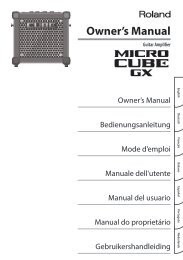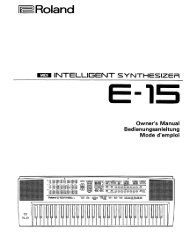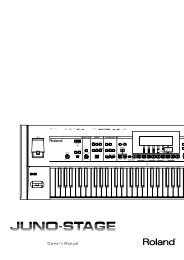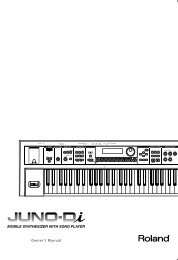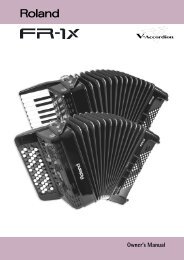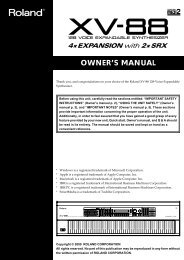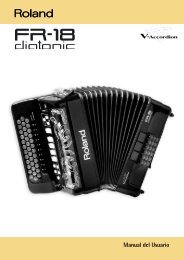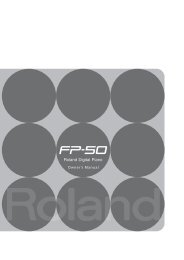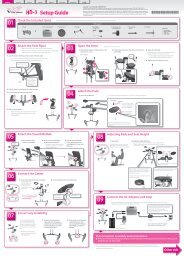Owner's Manual - Roland
Owner's Manual - Roland
Owner's Manual - Roland
Create successful ePaper yourself
Turn your PDF publications into a flip-book with our unique Google optimized e-Paper software.
Mono/Poly<br />
Set this parameter to “MONO” when the patch assigned to<br />
the part is to be played monophonically, or to “POLY” when<br />
the patch is to be played polyphonically. If you want to use<br />
the Mono/Poly setting of the patch assigned to the part (p.<br />
99), set this to “PAT.”<br />
Value: MONO, POLY, PAT<br />
Legato Switch<br />
This setting is ignored for parts to which a rhythm set is<br />
assigned.<br />
You can add legato when performing monophonically. The<br />
term “legato” refers to a playing style in which notes are<br />
smoothly connected to create a flowing feel. This creates a<br />
smooth transition between notes, which is effective when<br />
you wish to simulate the hammering-on and pulling-off<br />
techniques used by a guitarist.<br />
Turn this parameter “ON” when you want to use the Legato<br />
feature and “OFF” when you don’t. If you want to use the<br />
Legato Switch setting of the patch assigned to the part (p.<br />
99), set this to “PAT.”<br />
Value: OFF, ON, PAT<br />
This setting is ignored for parts to which a rhythm set is<br />
assigned.<br />
Portamento Switch<br />
Specify whether portamento will be applied. Turn this<br />
parameter “ON” when you want to apply Portamento and<br />
“OFF” when you don’t. If you want to use the Portamento<br />
Switch setting of the patch assigned to the part (p. 100), set<br />
this to “PAT.”<br />
Value: OFF, ON, PAT<br />
This setting is ignored for parts to which a rhythm set is<br />
assigned.<br />
Portamento Time<br />
Creating a Performance<br />
When portamento is used, this specifies the time over which<br />
the pitch will change. Higher settings will cause the pitch<br />
change to the next note to take more time. If you want to use<br />
the Portamento Time setting of the patch assigned to the<br />
part (p. 100), set this to “PAT.”<br />
Value: 0–127, PAT<br />
Vibrato Rate<br />
This setting is ignored for parts to which a rhythm set is<br />
assigned.<br />
For each part, adjust the vibrato speed (the rate at which the<br />
pitch is modulated). The pitch will be modulated more<br />
rapidly for higher settings, and more slowly with lower<br />
settings.<br />
Value: -64– +63<br />
Vibrato Depth<br />
For each part, this adjusts the depth of the vibrato effect (the<br />
depth at which the pitch is modulated). The pitch will be<br />
modulated more greatly for higher settings, and less with<br />
lower settings.<br />
Value: -64– +63<br />
Vibrato Delay<br />
For each part, this adjusts the time delay until the vibrato<br />
(pitch modulation) effect begins. Higher settings will<br />
produce a longer delay time before vibrato begins, while<br />
lower settings produce a shorter time.<br />
Value: -64– +63<br />
139<br />
Overview Connections VS-700C Console VS-700R I/O Fantom VS Appendix



